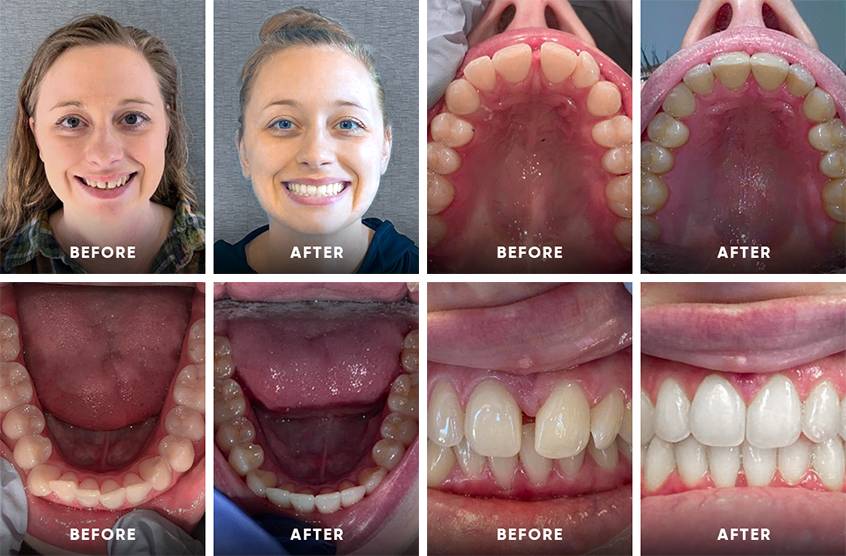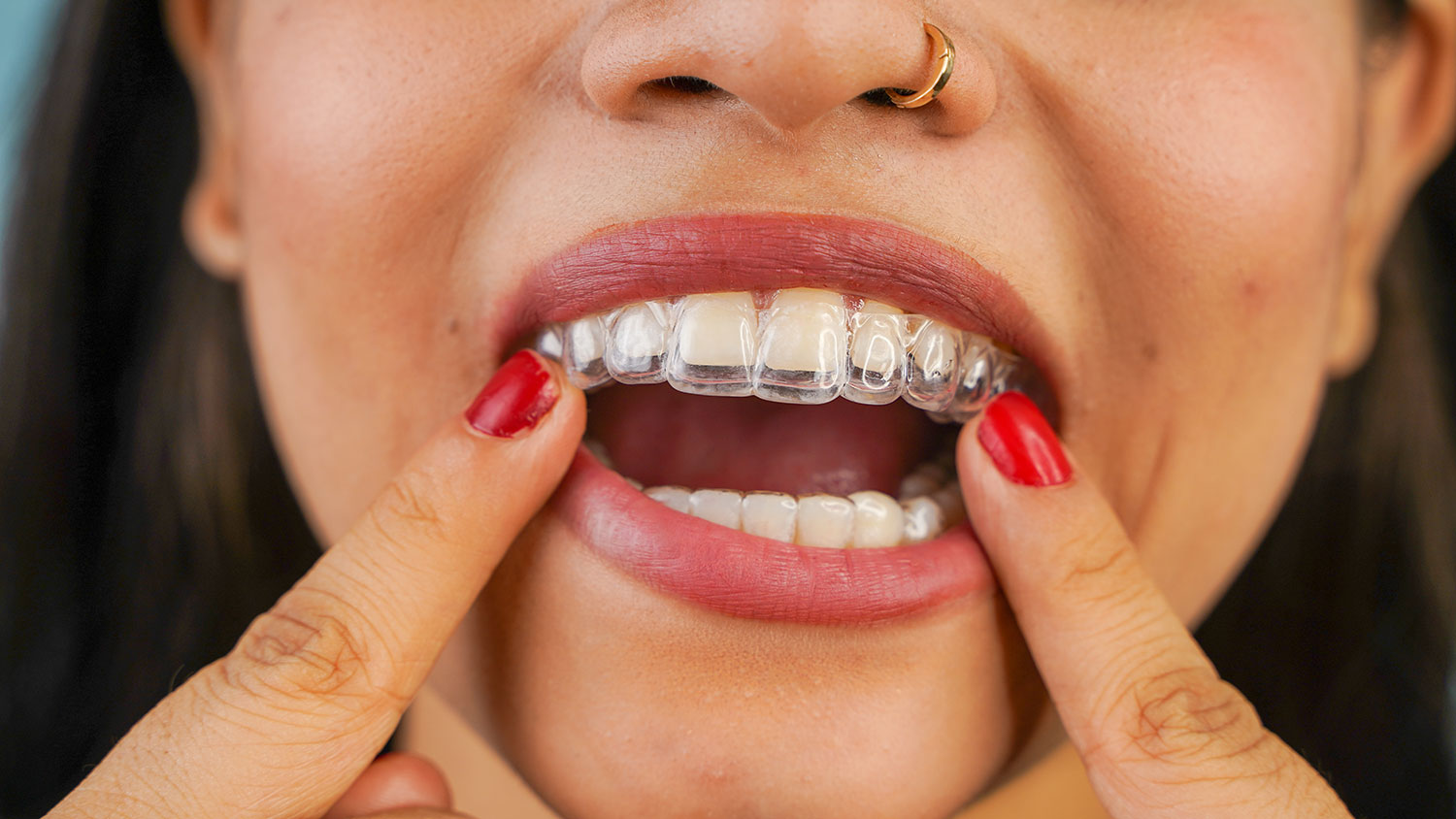Discover the Perks of Invisalign for a Perfect Smile Change
Discover the Perks of Invisalign for a Perfect Smile Change
Blog Article
Invisalign vs. Conventional Braces: Which Choice Is Right for You?
When considering orthodontic treatment, the option in between Invisalign and typical dental braces provides numerous essential elements that warrant careful examination. Invisalign supplies a very discreet alternative with detachable aligners, while typical dental braces offer a more visible yet effective option for severe imbalance.
Introduction of Therapy Choices

On the other hand, typical dental braces contain metal braces and wires that are bonded to the teeth. This method uses constant stress in time to attain placement. While efficient for intricate orthodontic concerns, traditional braces call for normal check outs for adjustments and can present challenges in preserving dental hygiene because of the trouble of cleaning around brackets and cords.
Both options have their benefits, and the option typically rests on specific dental problems, way of living choices, and client compliance. Eventually, consulting an orthodontic specialist is vital for establishing the most appropriate therapy plan customized to individual needs. Understanding the nuances of each choice can considerably influence the general success of orthodontic treatment.
Aesthetic Factors To Consider
A considerable factor influencing the choice in between Invisalign and traditional dental braces is the visual appeal each treatment uses. Invisalign aligners are crafted from clear plastic, making them virtually invisible when used.
In contrast, traditional braces consist of metal braces and cords, which can be extra noticeable. While improvements in orthodontic innovation have caused the advancement of smaller sized braces and tinted elastics, standard dental braces still maintain a more obvious profile. For some people, the visibility of braces might hinder them from seeking essential therapy.
Eventually, the option in between Invisalign and traditional braces might rest on personal preferences pertaining to aesthetics. People that prioritize discretion typically favor Invisalign, while those that are less worried concerning exposure may go with typical braces. Recognizing the visual implications of each alternative is important for making an educated decision that straightens with one's way of life and choices.
Comfort and Convenience

In terms of benefit, Invisalign aligners are detachable, enabling clients to enjoy their favored foods without restriction and preserve optimum oral health. Cleaning and flossing are streamlined, as the aligners can be gotten throughout these routines, whereas traditional braces need cautious navigating around braces and wires.
In contrast, conventional braces necessitate normal changes, making them less practical for those with busy routines. On the whole, the comfort and convenience of Invisalign make it an enticing option for many individuals looking for orthodontic therapy.
Treatment Duration and Efficiency
While both Invisalign and conventional dental braces work in fixing dental imbalances, the duration of treatment can differ dramatically in between both choices. Typically, Invisalign therapy can take anywhere from 12 to 18 months, relying on the complexity of the instance. The clear aligners work by slowly shifting teeth right into their wanted settings, and routine follow-ups with an orthodontist assistance make certain development remains on the right track.
In comparison, standard dental braces commonly need a longer commitment, typically ranging from 18 months to three years. This is because of their set nature and using brackets and wires, which can be much more reliable for serious misalignments and intricate situations (Invisalign). The therapy effectiveness of typical braces is well-documented, as they enable accurate adjustments and higher control over tooth movement
Inevitably, the selection between Invisalign and typical braces may rest on both the expected treatment period click for more and the certain dental issues handy. Consulting with an orthodontist is vital, as they can offer customized suggestions based on private demands, making certain the chosen approach straightens with wanted durations and end results.
Price Contrast and Insurance Alternatives
Expense plays a significant duty in the decision-making process for people thinking about orthodontic treatment, whether deciding for Invisalign or standard dental braces. Typically, the cost of Invisalign ranges from $3,000 to $8,000, while traditional braces usually he said set you back in between $2,000 and $6,000. Elements influencing these prices consist of the complexity of the case, the duration of therapy, and geographical place.
Several dental insurance coverage plans provide partial coverage for orthodontic therapies, however the specifics can vary commonly. Typically, traditional braces may be a lot more frequently covered by insurance coverage strategies contrasted to Invisalign, which some insurance companies categorize as a cosmetic treatment.
In addition, numerous orthodontic practices provide flexible layaway plan, making both therapy choices more accessible. Individuals need to ask about possible financing options and price cuts for upfront settlements. Evaluating the overall price, consisting of insurance policy advantages and layaway plan, is essential for making an informed choice that lines up with both visual preferences and budget considerations.

Final Thought
In recap, the selection between Invisalign and typical dental braces depends upon numerous variables, consisting of aesthetic choices, comfort, therapy period, and price. Invisalign offers a very discreet, detachable choice that promotes oral hygiene and nutritional versatility, while standard dental braces may be preferable for complicated oral concerns and typically come at a reduced price factor. Eventually, examination with an orthodontist is important to evaluate specific Get the facts conditions and figure out one of the most appropriate treatment alternative for attaining optimal dental placement.
When taking into consideration orthodontic therapy, the option in between Invisalign and traditional braces presents a number of vital variables that warrant mindful examination.Contrasting Invisalign and conventional dental braces discloses distinctive treatment choices for orthodontic improvement.While both Invisalign and typical dental braces are effective in dealing with oral misalignments, the duration of treatment can differ considerably between the 2 alternatives.Expense plays a significant function in the decision-making process for individuals considering orthodontic treatment, whether opting for Invisalign or traditional braces.In summary, the choice in between Invisalign and traditional braces pivots on several variables, including aesthetic preferences, convenience, therapy duration, and cost.
Report this page